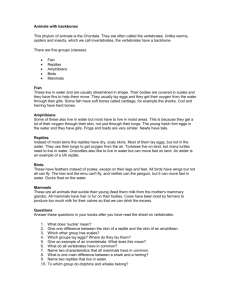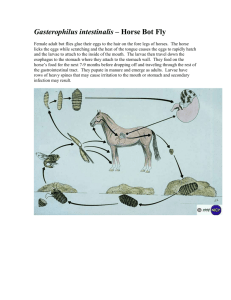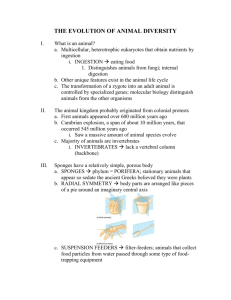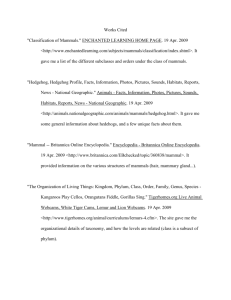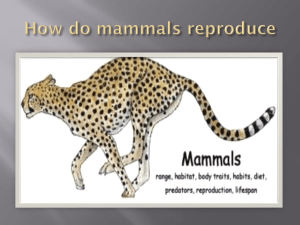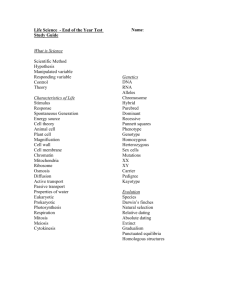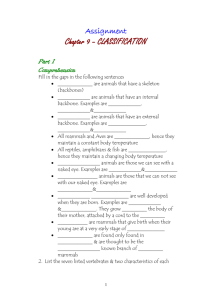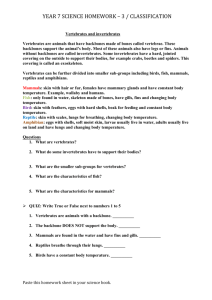Kingdom Animalia - North High School
advertisement
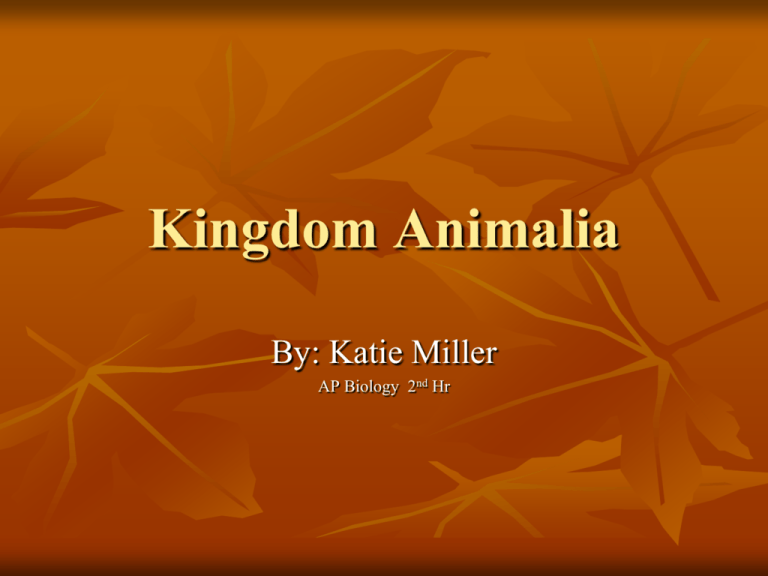
Kingdom Animalia By: Katie Miller AP Biology 2nd Hr Phylum Coelenterata Ex: Sea Anemones Cnidarians are carnivores that use their tentacles to capture small animals and protists and to push the prey into their mouths. The mouth leads into a digestive compartment called the gastrovascular cavity. The mouth is the only opening in the body, so undigested food and other wastes exit through it. It also circulates fluid that services internal cells. Acting as a hydrostatic skeleton, fluid in the cavity provides body support and helps give a cnidarian its shape, much like a balloon. Cnidarians exhibit two kinds of body forms: Polyp and the Medusa. Some Cnidarians pass sequentially through a polyp stage and a medusa stage in their life cycle. Others exist only as on or the other. Class Schyphozoa Ex: Jellyfish Four oral arms hang from the middle of a jellyfish’s bell, surrounding its mouth. Oral arms are also covered with stinging nematocysts. These cells contain a hollow, bared thread that fires on impact or in response to a chemical cue. Many are toxic, used to paralyze or kill their prey. There are separate sexes, male and female, though these are not easily distinguished by sight. Reproduction begins when the male releases sperm through its mouth into the surrounding water. These swim to the female where they enter her central oval cavity to reach the eggs. Once fertilized, the zygotes emerge onto the oral arms to develop for a time, becoming larvae which settle on the bottom of the ocean. Results in polyp that buds and produces free-swimming medusae. Class Anthozoa The stomach cavity is partioned by longitudinal membranes called mesenteries. The edges of the mesenteries support long mobile filaments. The mesentery filaments protrude through the mouth to capture food. Reef development is generally more abundant in areas that are subject to strong wave action. Waves carry food, nutrients, and oxygen to the reef; distribute coral larvae; and prevent sediment from setting on the coral reef. Phylum Porifera Ex: Sponges The body of a sponge consists of two layers of cells separated by a gelatinous region. The inner layer of flagellated cells called choanocytes help to sweep water through the sponge’s body. Wandering through the middle body region are amoebocytes, which produce skeletinous fibers composed of either mineral containing particles or a flexible protein called spongin. Sponges can reproduce sexually or asexually. Asexual reproduction is through internal and external budding. External budding occurs when the parent sponge grows on a bud on the outside of its body. This will break away or stay connected. Internal budding occurs when archaeocytes collect in the mesohyl and become surrounded by spongin. In sexual reproduction, sperm are dispersed by water currents and enter neighboring sponges. All sponges of a particular species release their sperm at approximately the same time. Phylum Platyhelminthes Characteristics: 1. 2. 3. 4. 5. Bilaterally Symmetrical with a head and a tail. Centralized nervous system Three tissue layers. No body cavity, no circulatory system, and no hard skeleton. Most contain a gastrovascular cavity (with one hole) (which helps distribute food throughout the animal). Class Turbellaria A Planarian has a head with a pair of light sensitive eye spots and a flap at each side that detects chemicals. Dense clusters of nerve cells from a simple brain, and a pair of nerve cords connect with small nerves that branch through out the body. Planarians live on the undersurfaces of rocks in fresh water ponds and streams. Using cilia on their ventral surface, they crawl about in search of food. They also have muscles that enable them to twist and turn. Class Trematoda Many Flukes have suckers that attach to their host and a tough protective covering. Reproductive organs occupy nearly the entire interior of these worms. Most Flukes have complex life cycles with an intermediate host in which larvae develop. The larvae then infect the final host in which they also live as adults. Ex: Blood Flukes – Flukes that parasitize humans spend part of their life cycle in snails (causes Schistosomiasis). Class Cestoda Tapeworms have a very long, ribbon – like body with repeated units. They also do not have a digested food in the intestines of their hosts, they simply absorb nutrients across their body surface. The anterior end of the tapeworm, called scolex, is armed with the hooks and suckers that grasp the host. Tapeworms have complex life cycles, usually involving more than one host. Most species benefit from the predator – prey relationships of their hosts. Larval tapeworms develop in their hosts, and a predator, a coyote or a dog for instance, becomes infected when it eats an infected prey animal. The adult tapeworms develop in the predator’s intestines. Phylum Nematoda Nematodes have a complete digestive tract, extracting as a tube from the mouth to the anus near the tip of the tail. Food travels only one way through the system and is processed as it moves along. In animals with a complete digestive tract, the anterior regions of the tract churn and mix food with enzymes, while the posterior regions absorb nutrients and then dispose of wastes. Most nematodes are dioecious. Fertilization takes place when males use special copulatory spines to open the females’ reproductive tracts and inject sperm into them. The sperm are unique in that they lack flagellae and move by pseudopodia, like amoebas. Development of fertilized eggs is usually directs. Leeches Phylum Annelida Annelids Annelids have a closed circulatory system, in which blood remains enclosed in vessels as it distributes nutrients and oxygen throughout the body. Since all members of this group are to some extent segmented, the circulatory, nervous, and excretory body systems are located in each segment. Annelids range in length from less than 1mm to 3m, the length of some giant Australian earthworms. They are found in damp soil, in the sea, and in most fresh water habitats. Some aquatic annelids swim in pursuit of food, but most are bottom-dwelling scavengers that burrow in sand and mud. Molluscs Phylum Mollusca The basic body plan of a Mollusc, consists of three main parts: a muscular foot, which functions in locomotion; a visceral mass containing most of the internal organs; and a mantle, a fold of tissue that drapes over the visceral mass and secretes a shell in molluscs such as clams or snails. In many molluscs, the mantle extends beyond the visceral mass, producing a water-filled chamber called the mantle cavity, which houses the gills. Most Molluscs have separate sexes, with reproductive organs located in the visceral mass. The life cycle of many marine molluscs includes a ciliated larva called a trochophore, which is also characteristic of some other invertebrate phyla. Class Pelecypoda Bivalves have shells divided into two halves that are hinged together. Most bivalves are suspension feeders. The mantle cavity contains the gills that are used for feeding as well as gas exchange. The mucus-coated gills trap fine food particles suspended in the water, and cilia sweep the particles to the mouth. Most bivalves are sedentary, living in sand or mud. They may use their muscular foot for digging and anchoring. Mussels are sessile, secreting strong threads that attach them to rocks, docks, and boats. Class Gastropoda Most gastropods are protected by a single, spiraled shell into which the animal can retreat when threatened. Many gastropods have fidtinct had with eyes at the tips of tentacles. Terrestrial snails lack the gills typical of aquatic molluscs; instead the lining of the mantle cavity functions as a lung, exchanging gases with the air. Gastropods are dioecious, and some forms are hermaphroditic. Hermaphroditic forms exchange bundles of sperm to avoid selffertilization; copulation may be complex and in some species ends with each individual sending a sperm-containing dart into the tissues of the other. Marine species have Veliger larvae. Class Cephalopoda All Cephalopods have large brains and sophisticated sense organs, and these contribute to their being successful, mobile predators. Cephalopod eyes (among the most complex in the animal kingdom) contains a lens that focuses light and a retina on which clear images form. Octopuses are considered the most intelligent. Squids considered the largest. Cephalopods are gonochoric. All female typically possesses a single oviduct. A male produces spermatophores that it transfers to the female’s genital pore by means of a specialized arm or tentacle. Mating in some cephalopods includes courtship rituals that may consist of color changes, body movements, or combinations of both. Phylum Echinodermata Echinoderms have a water vascular system, a net work of water-filled canals that branch into extensions called tube feet. Tube feet function in locomotion, feeding, and gas exchange. Echinoderms are deuterostomes. The larvae, which are planktotrophic, have three-partpaired coeloms. Embryonic coelomic structures have specific fates as the bilaterally symmetrical larvae metamorphose into radially symmetric adults. Crabs Phylum Arthropoda Barnacles The arthropod body including the appendages, is covered by an exoskeleton, an external skeleton that provides points of attachment for the muscles that move the appendages. This non-living covering, or cuticle, is constructed from layers of protein and chitin, a polysaccharide. As it grows, an arthropod must periodically shed its old exoskeleton and secrete a larger one, a complex process called molting. Spiders Arthropods are common throughout marine, freshwater, terrestrial, and even aerial environments, as well as including various symbiotic and parasitic forms. Class Crustacea All crustaceans have two pairs of antennae, a pair of mandibles, a pair of compound eyes, and two pair of maxillae on their heads, followed by a pair of appendages on each body segment. The appendages are primitively branched, and although this condition is modified in many species, adults always have at least some biramous appendages crustaceans respire via gills. A Most crustaceans are dioecious. The actual mechanisms by which fertilization is achieved vary greatly. Some crustaceans hatch young that are like miniature adults; others go through a larval stage called a nauplius. Class Arachnida There are three important modifications that are particularly important for the terrestrial life style of an arachnid. First, the book gill is modified into a book lung, an internal series of vascular lamellae used for gas exchange with the air. Second, appendages are modified for more efficient locomotion on land. Third, water conservations enhanced by more efficient excretory structures. Arachnids are mostly carnivorous, feeding on the pre-digested bodies of insects and other small animals. Several groups are largely venomous; several mites are parasites that can be carriers of disease. Arachnids usually lay eggs, which hatch into immatures that resemble adults. Class Insecta Ex: Moths … INSECTS! Their nervous system can be divided into a brain and a ventral nerve chord. The head capsule (made up of six fused segments) has six pairs of ganglia. The first three pairs are fused into the brain, while the three following pairs are fused into a structure called the sub-esophageal ganglion. Many in sets undergo metamorphosis in their development. There are two types of metamorphosis: incomplete and incomplete. Incomplete – occurs when the young resemble adults but are smaller with different body portions. Complete – occurs when their larval stages are specialized for eating and growing and look very different from the adults which are specialized for dispersal and reproduction. Metamorphosis from larvae to adult occurs during a pupal stage. Class Chilopoda Centipedes have worm-like, flattened bodies. Most centipedes can only bite with their poison claws located directly under the head. Each walking leg is tipped with a sharp claw capable of making tiny cuts in human skin. Centipedes may be found in a variety of habitats but most prefer moist, protected places such as under stones, rotted, logs, leaves, or bark. They spend the winter as adults and lay eggs during the warm months. Generally, eggs are laid in the soil and covered by a sticky substances. A few species give birth to live young. Class Diplopoda Millipedes have two pairs of legs per segment (except for the first segment behind the head which does not have any appendages at all, and the next few which only have one pair of legs). Each segment that has two pairs of legs is a result of two single segments fused together as one. Most millipedes have very elongated cylindrical bodies, although some are flattened. Millipedes are usually restricted to moist places where they feed on organic matter (In the fall, they may invade homes), such as leaves, mulch, piles of wood, or wood chips. Class Trilobite The Trilobite had a ventral nervous system, either a pair of nerve chords, connected at segmental ganglia (swellings), or perhaps a single chord with segmented nodes. The brain would be an enlarged frontal ganglion receiving sensory imput from eyes and antennae, etc. Trilobites were among the most prominent of the paleozoic marine arthropods, and they have only been found in fossil beds. No freshwater forms have been found. They occupied many different ocean environments, from shallow flats and reefs, to deeper ocean bottoms, and even the water column, as floating plankton or free-swimming forms. Phylum Chordata Chordates are a group of animals that includes the Vertebrate, together with several closely related invertebrates. They are united by having at some time in their life cycle, a notochord, a hollow dorsal nerve chord, pharyngeal slits, an end style, and a post-anal tail. How they develop? The development of a chordate is dependent on the organism itself. It depends on which subphyla they are in because they all develop quite differently. Advantages: Adaptions to live on land? Subphylum Urochordata Tunicates are suspension feeders. They have two openings in their body cavity = an incurrent and an excurrent siphon. The incurrent siphon is used to intake food and water and the excurrent siphon expels waste and water. Most Tunicates are hermaphroditic. The eggs are kept inside their body until they hatch, while sperm is released into the water where it fertilizes other individuals when brought in with incoming water. Subphylum Cephalopoda Lancelets grow up to about five centimeters long, reaching eight centimeters at the longest. In common with vertebrates, the muscles are arranged in blocks called myomeres. Unlike the vertebrates, the dorsal nerve cord is not protected by bone, but a rather simpler notochord made up of a cylinder of cells that are closely packed to form a toughened rod. Lancelets live in sandy bottoms near the shore the larvae may drift over long distances before settling. The sexes are separate, and both males and females have multiple paired gonads. Eggs are fertilized externally, and develop into free-swimming, fish-like larvae. Subphylum Vertebrata Vertebrates, which include fishes, reptiles, amphibians, birds, and column, or a chain of bony elements that run along the dorsal surface from head to tail and form the main skeletal axis of the body. All vertebrates are easily distinguished from all other chordates by having an unequivocal head, that is, sensory organs – especially eyes are concentrated at the fore end of the body and there is pronounced cephalization (and Back Bone). With rare exceptions, vertebrates have two separate sexes. Most lay eggs and are said to be oviparous , but a number of fishes and snakes retain eggs in their bodies, and the eggs hatch internally. Other vertebrates have modified the egg so that the embryo is actively nourished by and inside the body of the mother. Class Agnatha • Jawless Lampreys have no paired fins, large eyes, one nostril on the top of the head, and seven gills on each side. The unique morphological characteristics of lampreys, such as their cartilaginous skeleton, mean that they are the sister taxon of all living jawed vertebrates and are not classified within the Vertebrata itself. fish Lampreys live mostly in coastal and fresh waters. The larvae are suspension feeders that resemble lancelets and spend much of their time buried in sediment. Most Lampreys migrate to the sea or lakes as they mature into adults. Example: Great Lakes Class Chondrichthyes The Chondrichthyes or cartilaginous fishes (sharks or rays) are jawed fish with paired fins, paired nostrils, scales, two-chambered hearts, and skeletons made of cartilage rather than bone. Sharks have a lateral line system, a row of sensory organs running along side that are sensitive to changes in water pressure and can detect minor vibrations caused by animals swimming nearby. Chimaeras usually live on muddy bottoms near the shore. Sharks live in coastal waters on the bottom or out at sea in open water or at the bottom. Skates and rays live on the bottom in saltwater or freshwater or move back and forth between the two. Class Osteichthyes • Bony Fish Bony fishes have skeletons that are almost completely calcified. The vertebral column, cranium, jaw, ribs, and intramuscular bones make up the bony fish skeleton. Depending on the species, bony fishes can live at various temperatures. Some live at extreme temperatures. Class Reptilia The class Reptilia includes turtles, snakes, lizards, alligators, and other large reptiles. Reptiles all have backbones, they all breathe air (even those that spend much of their lives in water) and they almost all have four limbs, although in the case of snakes and some lizards these are not usually visible externally. Reptiles are found in every conceivable kind of environment, from the driest and hottest deserts to the wettest, steamiest rainforests. They produce an amniote egg which usually has a leather hard shell that protects the embryo from drying out. This is an advantage over fish and amphibians because the amniote egg can be laid on land where it is usually safer from predators than it would be in lakes, rivers, and oceans. Class Amphibia With the development of lungs, there is a change in the circulatory system. The amphibian heart has a divided atrium but a single ventricle. The right atrium receives impure blood with little oxygen from the body proper, and the left atrium receives purified blood from the lungs that has just been oxygenated, but these two types of blood are mixed partially in the single ventricle. Mixed blood is then sent, in part, to the skin, where further oxygenation can occur. Amphibia spend part of their lives under water and part on land. Frogs, toads, and salamanders are amphibians. Many of these species must keep their skin moist by periodically returning to wet areas. All of them must return to water in order to reproduce since their eggs would dry out otherwise. They start life with gills, like fish, and later develop lungs to breathe air. For the purpose of reproduction most amphibians are bound to fresh water. A few tolerate brackish water, but there are no true seawater amphibians. Class Aves Birds Digestive - Birds digest food quickly, they can't afford the extra weight. They have no teeth, the breakdown of food occurs in the gizzard - sometimes birds swallow rocks to assist the process. The crop stores food; mother birds regurgitate food stored in the crop to their babies. Waste exits through the cloaca and so do eggs. In general, each species of bird occurs only within certain types of habitat. And each plant community - whether abandoned field, mixed deciduous/coniferous forest, desert, or freshwater marsh, for instance - contains its own predictable assortment of birds (many habitats). Class Mammalia Mammal Circulatory systems are divided into two circuits: pulmonary and systemic. The pulmonary circuit carries deoxygenated blood from the heart to the respiratory surface in the lungs, where it is reoxygenated, and then back to the heart. The systemic circuit carries oxygenated blood to all the body's cells via arteries, and deoxygenated blood back to the heart via veins. The mammalian double circulatory system is efficient because it uses a separate pump (the two ventricles) to power each circuit From the coldest arctic ice to the hottest deserts you will find mammals living and thriving. There seems to be no climate that they can't adapt to, however changeable it may be. There is a good reason for this - mammals have the ability to keep their body at a constant temperature whatever the weather. Order Monotremata Egg-laying Mammals Monotremes are mammals that lay eggs (Prototheria) instead of giving birth to live young, which is a trait found in no other mammals. Monotremes retain a reptile-like gait, with legs that are on the sides of rather than underneath the body. The monotreme leg bears a spur in the ankle region; the spur is non-functional in echidnas, but contains a powerful venom in the male platypus. The modern platypus is distributed among the freshwater systems of eastern Australia where it occurs in abundance, though its range does appear to have been rather reduced since the 19th century. Of the echidnas, Tachyglossus has the greater range, occurring in eastern Australia, as well as New Guinea and Tasmania. Zaglossus is apparently restricted to New Guinea. Order Marsupialia Marsupials are mammals in which the female typically has a pouch in which it rears its young through early infancy. Marsupials have a brief gestation and give birth to tiny, embryonic offspring that complete development while attached to the mother’s nipples. The nursing young are usually housed in an external pouch, called the marsupium. Nearly all Marsupials live in Australia, New Zealand, and North and South America. Marsupials have diversified to fill different terrestrial habitats (filling different ecological niches based on location in Australia, etc). Order Artiodactyla Organisms in this order are called the even-toed ungulates because their weight is borne about equally by the third and fourth toes, rather than mostly or entirely by the third. Another key distinguishing feature is the shape of the astralagus (a bone in the ankle), which has a double-pulley structure in artiodactyls, giving the foot greater flexibility. Artiodactyls are native to all continents except Australia and Antarctica. The group contains a number of domesticated species. Ecologically, they range from forest dwellers, such as wild pigs and chevrotains, to dominant large herbivores on grasslands. Artiodactyls have colonized a number of biomes characterized by extreme conditions. Order Carnivora Carnivorans have strong sharp claws, with never less than four toes to each foot, and welldeveloped prominent canine teeth and cheek teeth that generally have cutting edges. The last premolar of the upper jaw and first molar of the lower are termed the carnassials or sectorial teeth. These are blade-like teeth that occlude (close) with a scissor-like action for shearing and shredding meat. Carnivorans have either four or five digits on each foot. The order Carnivora can be found throughout the world, naturally occurring on all continents except Australia, New Guinea, New Zealand, some oceanic islands, and Antarctica, and are able to adapt to all major types of habitats. Order Cetacea Ex: Whales Cetaceans are the mammals most fully adapted to aquatic life. Their body is fusiform (spindle-shaped). The forelimbs are modified into flippers. The tiny hind limbs are vestigial; they do not attach to the backbone and are hidden within the body. The tail has horizontal flukes. Cetaceans are nearly hairless, and are insulated by a thick layer of blubber. As a group, Cetaceans are noted for their high intelligence. The order Cetacea contains ninety species, all marine except for five species of freshwater dolphins. Cetaceans live, breed, rest, and carry out all of their life functions in the water. Order Chiroptera Ex: Bats The most distinguishing feature of Chiropterans is their forelimbs which are developed as wings, making them the only mammals in the world naturally capable of flight. Bats as a group are crepuscular or nocturnal; their eyes are small and inefficient, but their ears are usually well developed. Bats are found throughout the world in tropical and temperate habitats. They are missing only from polar regions and from some isolated islands. Although bats are relatively common in temperate regions, they reach their greatest diversity in tropical forests. Order Xenarthra Ex: Armadillo The toothless anteaters are provided with heavy claws to tear apart termite nests and a long, slender, protrusile, sticky tongue to capture the insects. The slowmoving, plant-eating sloths are tree dwellers, with a rudimentary tail and only two or three toes on each foot. In the large group of armadillos, the presence of a bony carapace is unique among mammals. NOTE : In the past, these families were classified together in the order Edentata (meaning toothless, because the members do not have front incisor teeth or molars, or have poorly-developed molars). It was subsequently realized that Edentata was polyphyletic—that it contained unrelated families and was thus invalid by cladisitc standards. Its members are bizarre creatures and highly specialized in structure and habits. The Order is divided into three families, all of which are restricted to Central and South America with the exception of one species, the nine-banded armadillo, which ranges north to the United States. • The most notable feature of their postcranial skeleton are the special articulations ( xenarthrous processes) on the lumbar vertebrae. These are found in no other mammals. Order Insectivora Ex: Moles and Shrews The name insectivora (insect eater) has reference to the food habits of the group as a whole. Although moles and shrews are not all strictly insectivorous, insects and other small animal life constitute the chief dietary items of most members of the group. The eyes are usually very small, the feet are plantigrade and have five digits. Most American shrews live on the surface of the ground and occupy burrows only for sleeping or resting. Most of them have a decided preference for damp or boggy habitats where rank vegetation, surface litter, rocks, or rotting logs afford adequate protection. Moles, as a group, are subterranean in habit and spend most of their lives in the darkness of underground tunnels which they usually excavate for themselves. Order Lagomorpha Ex: hares, pikas, and rabbits Mammals assigned to this Order superficially resemble rodents, but lagomorphs differ from rodents in several essential features. One of these is the peculiar tandem arrangement of the front (incisor) teeth, with a large tooth in front on each side and a small peg-like tooth directly behind it. Also, the number of premolars is different, so that the total number of teeth is 26 or 28 and never as few as the 16 to 22 found in rodents. All lagomorphs are terrestrial. They occupy a wide diversity of habitats, ranging from tropical forest to arctic tundra. All are herbivores that feed on grasses and other small plants. Order Perissodactyla Ex: Rhinos The odd-toed ungulates (animals having an odd number of toes on each hoof) are usually large, have relatively simple stomachs and a large middle toe. The name of their order derives from the fact that their middle toe is larger than the others, and the plane of symmetry of the foot passes through it. In other words, they either walk on three toes (like rhinos, tapirs, many extinct horses, and other extinct groups) or on a single toe (like recent horses). Modern perissodactyls are native to Africa, south and central Asia, southern North America, and northern South America. Most species are herbivorous. (Most live in tropical regions). Order Primate Ex: MONKEYS! • All primates have five fingers (pentadactyl), a generalized dental pattern, and a primitive (unspecialized) body plan. Another distinguishing feature of primates is finger nails. • All primates, even those that lack the features typical of other primates (like lorises), share eye orbit characteristics, such as a postorbital bar, that distinguish them from other taxonomic orders. They are essentially tropical in distribution, found in the Americas, Africa, and southern Asia, although man has extended the distribution to the coldest of polar expeditions - indeed even to extraterrestrial orbs. Human! Order Probascidea Ex: Elephants, Mammoths, Mastodons Obviously, elephants are easily recognized by their amazingly strong and long trunk. The trunk is also quite sensitive, with the tip being able to pick up the smallest of objects with ease. The tusks are elongated upper incisors, and elephants have no canines or premolars. The huge molars are used to grind their vegetarian food, are replaced successively from behind as they wear down. The sole survivors of a once prevalent order are the two species of elephants, those colossal pachyderms (thick skins) which inhabit Africa south of the Sahara, as well as India, Sri Lanka, and southeast Asia. Although today's elephants are limited to the specific warmer areas of Africa and Southeast Asia, their precursors were found on every continent but Australia and Antarctica, and inhabited every type of climate, with the wooly mammoth wandering into the coldest of winters. Order Rodentia Ex: Squirrel Rodentia is an order of mammals also known as rodents, characterized by two continuously-growing incisors in the upper and lower jaws which must be kept short by gnawing. The teeth have enamel on the outside and exposed dentine on the inside, so they self-sharpen during gnawing. Rodents lack canines, and have a space between their incisors and premolars. Forty-percent of mammal species are rodents, and they are found in vast numbers on all continents other than Antarctica. Order Sirenia Ex: Manatees Sirenians, including manatees and the Dugong, have major aquatic adaptations: forelimbs have modified into arms used for steering, the tail has modified into a paddle used for propulsion, hind limbs (legs) are but two small remnant bones floating deep in the muscle. They appear fat, but are fusiform, hydrodynamic, and highly muscular. Their skulls are highly modified for taking breaths of air at the water's surface and dentition is greatly reduced. Sirenia is an order of fully aquatic, herbivorous mammals that inhabit rivers, estuaries, coastal marine waters, swamps, and marine wetlands. THE END
